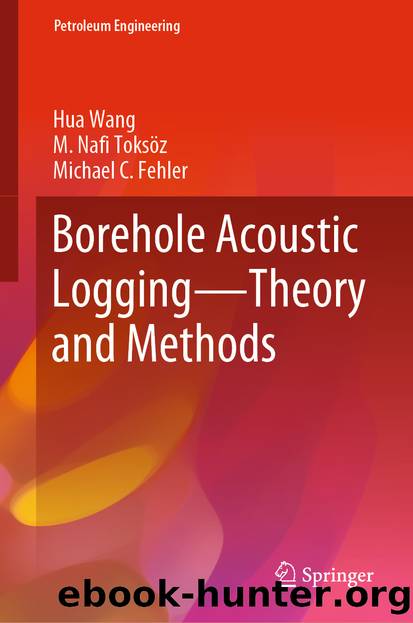Borehole Acoustic Logging—Theory and Methods by Hua Wang & M. Nafi Toksöz & Michael C. Fehler

Author:Hua Wang & M. Nafi Toksöz & Michael C. Fehler
Language: eng
Format: epub
ISBN: 9783030514235
Publisher: Springer International Publishing
The quadrupole ALWD waveforms in the very slow formation S2 are shown for different source frequencies in Fig. 5.39. The waveforms are normalized by the maximum amplitude at 2 kHz. The waveforms include the early arrivals (collar screw and leaky P-wave) and later arrival (formation screw wave).
Fig. 5.39Quadrupole ALWD waveforms at the 3 m offset at different source frequencies in formation S2. Vertical line shows arrival time of formation screw wave, which does not change with frequency
The arrival time of the formation screw waves does not change with the source frequency. However, its amplitude decreases as the source frequency increases. The formation S-wave velocity in the very slow formation can be measured best by a low-frequency quadrupole tool.
In the earlier arrivals (approximately 2 ms in Fig. 5.39), there is the leaky P-wave. The amplitude of leaky P increases with the increasing source frequency. When the source frequency increases above the cutoff frequency, the collar screw mode is excited. The amplitude of the collar wave increases with the increasing source frequency. The weak leaky P-wave is submerged within the coda of the collar screw wave.
The leaky P-wave is affected by the formation Poisson’s ratio. Figure 5.40 shows the effect of the formation S-wave velocity on the dispersion curves when the formation P-wave velocity is fixed at 2000 m/s and the formation S-wave velocity changes from 500 to 1000 m/s. The dispersion curves of the collar screw modes are not affected by the changing formation S-wave velocity. The dispersion curve of the leaky P-wave moves to higher frequency when the formation S-wave velocity is increased.
Fig. 5.40The impact of formation S-wave velocity on the dispersion curves in the quadrupole ALWD measurement in very slow formations. The P-wave velocity of the formation is 2000 m/s and the S-wave velocity changes from 500 to 1000 m/s. Lines for different S-wave velocities are listed in the right plot
Download
This site does not store any files on its server. We only index and link to content provided by other sites. Please contact the content providers to delete copyright contents if any and email us, we'll remove relevant links or contents immediately.
| Automotive | Engineering |
| Transportation |
Whiskies Galore by Ian Buxton(41529)
Introduction to Aircraft Design (Cambridge Aerospace Series) by John P. Fielding(32888)
Small Unmanned Fixed-wing Aircraft Design by Andrew J. Keane Andras Sobester James P. Scanlan & András Sóbester & James P. Scanlan(32573)
Craft Beer for the Homebrewer by Michael Agnew(17933)
Turbulence by E. J. Noyes(7700)
The Complete Stick Figure Physics Tutorials by Allen Sarah(7138)
Kaplan MCAT General Chemistry Review by Kaplan(6595)
The Thirst by Nesbo Jo(6435)
Bad Blood by John Carreyrou(6274)
Modelling of Convective Heat and Mass Transfer in Rotating Flows by Igor V. Shevchuk(6222)
Learning SQL by Alan Beaulieu(6035)
Weapons of Math Destruction by Cathy O'Neil(5829)
Man-made Catastrophes and Risk Information Concealment by Dmitry Chernov & Didier Sornette(5646)
Digital Minimalism by Cal Newport;(5389)
Life 3.0: Being Human in the Age of Artificial Intelligence by Tegmark Max(5184)
iGen by Jean M. Twenge(5161)
Secrets of Antigravity Propulsion: Tesla, UFOs, and Classified Aerospace Technology by Ph.D. Paul A. Laviolette(4990)
Design of Trajectory Optimization Approach for Space Maneuver Vehicle Skip Entry Problems by Runqi Chai & Al Savvaris & Antonios Tsourdos & Senchun Chai(4839)
Electronic Devices & Circuits by Jacob Millman & Christos C. Halkias(4748)
